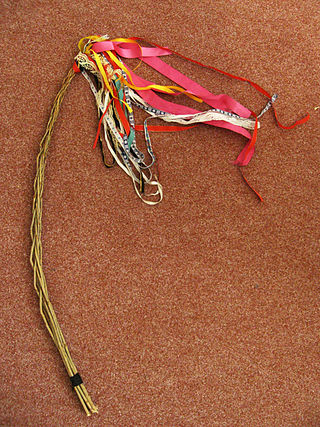Easter whip
Czech and Slovakian tradition From Wikipedia, the free encyclopedia
In the Czech Republic, Slovakia, and some parts of Hungary, the Easter whip is used as part of a tradition in which females are whipped with a decorated willow branch—and/or splashed with water—on Easter Monday.


The tradition typically takes place on the morning of Easter Monday, and involves a special handmade whip or switch called a pomlázka or karabáč (in Czech); korbáč, šibák, or šibačka (in Slovak); or siba or korbács (in Hungarian). The pomlázka consists of four to twenty-four withies, and usually measures from half a metre to two metres long, and is decorated with coloured ribbons at its tip.
Women wear multiple long dresses to avoid the minor pain that would be caused by the whipping. If men arrive at a woman's house after midday, the women throw a bucket of cold water on them. In some regions, men also douse girls with water or spray perfume on them.
When going house to house, the male first sings a rhyme related to eggs and other spring themes, such as generosity and fertility. If the woman does not have any decorated eggs, she turns around and allows the man to strike her legs with the whip.[1] While the spanking may be painful, it is not intended to cause suffering. However, the praxis is often different: research from 2022 shows that 45% of women endured pain during whipping, 27% ended up with bruises and 18% endured feelings of powerlessness and humiliation (n=694)[2] and research from 2023 shows similar results.[3] Research further shows that around 80% of women do not like this tradition, however, around half of asked women endure it even though they do not like it because they consider it to be customary, while only 30% try to avoid it.[2][3] Another significant finding from the same research is that younger women are more likely to state that they endured humiliation during whipping - this trend may reflect the willingness of younger genaration to admit their negative feelings towards this controversial tradition because the awareness of the topic of explotation of women has become more widespread lately. In cities, it is usually practiced only among family members.
In the past, young boys would chase young girls on village streets with the whips, and vintage illustrations of people in traditional dress show girls running or hiding. Playful running around—similar to the game of tag—still occurs, but aggressive ambushing is now considered unacceptable bullying by the modern generation. However, there is also a negative side to this tradition - research shows that up to one third of the population sees excesive consumption of alcohol during Easter whipping as the most significant problem of this tradition (n=1354).[2]
Tradition says that women should be spanked with a whip in order to maintain their health, beauty, and fertility throughout the following year.[4]
According to a 2019 survey, 60% of Czech households follow the tradition of spanking (or watering) someone on Easter Monday.[5]
In Croatia, the whip is made of olive twigs, but is not actually used for whipping.[6][7] In some countries, such as Poland, Easter palms or pussy willows are used.[8]
Etymology
"Wicker whip": Czech karabáč; Slovak korbáč (the standard name for "whip" is bič and korbáč, itself originating from Turkish kırbaç, usually means only one particular type: the "wicker whip"); Hungarian korbács.[9]
In the Czech Republic, such a whip is called a pomlázka meaning "rejuvenator", implying that a female struck by a pomlázka will become younger and prettier.
See also
References
Wikiwand - on
Seamless Wikipedia browsing. On steroids.
